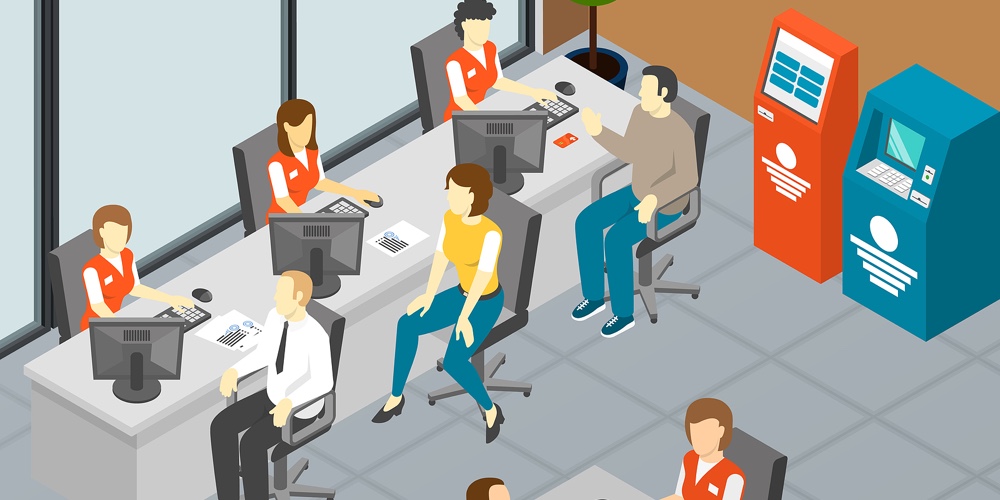My marketing agency is a passionate proponent of the “digital branch.” When we redesign credit union websites, we want to create a seamless and delightful user experience that motivates members to explore, engage, and improve their financial health.
But despite all the hype in recent years over the death of branches, we have always believed that a big part of what makes credit unions special is their commitment to a digital + human approach. This means that credit unions should maintain, and perhaps consider expanding, their physical presence—particularly in underserved communities.
Why? You’re likely familiar with the ways that “food deserts”—areas where local residents don’t have access to affordable, healthy food—have direct negative impacts on a community’s health and well being. “Branch deserts” are no different, and they’re multiplying across the country.
How branch deserts impact communities
On net, U.S. banks closed a record 2,927 branches last year.
That’s more than eight branches a day, and a 38% increase over the previous year—stats that are both startling and not-so-startling considering the push to digital banking and the move toward consolidation, especially during Covid. Even before Covid, closures were becoming commonplace—did you know over 13,000 branches have closed since 2008?
According to American Banker, the record closing levels of 2021 are likely to continue throughout 2022 and even into 2023. Most closures are coming from the largest banks, but institutions of all sizes are cutting their branch networks. Data from the FDIC showed that on a percentage basis community banks had a higher rate of branch closings in metro areas than non-community banks.
Key drivers include mergers and acquisitions (and the cost-cutting moves that tend to go with them) and a move to digital channels. Labor shortages and growing labor costs also contribute to the struggle to keep branches open.
In branch deserts, you are more likely to see:
- Higher levels of violence. As this recent New York Times article asserted, there’s a strong overlap between violence and poverty, caused in part by the link between poverty and a lack of institutionalized support. That includes a lack of in-person financial services. Click through to the article for some truly startling statistics linking shootings in Chicago to the distance lived from a bank.
- More payday lending. It will likely come as no surprise to learn that people with limited access to traditional financial services often turn to payday lenders when they need a loan. Research from LendingTree found that payday lenders were more likely to be in low-income communities, areas with higher rates of Black residents and places with fewer regulations.
According to the Consumer Financial Protection Bureau (referenced in the LendingTree article), 80% of payday loans are rolled into a new payday loan within two weeks. These rollovers lead to eye-popping interest rates—somewhere in the neighborhood of 400% is common—and it’s not unusual for the amount the borrower pays in fees to exceed the original amount of money borrowed.
- Less economic mobility. According to the Federal Reserve Bank of Atlanta, small businesses struggle and overall community development wanes when there’s limited access to financial services.
Although banking deserts might seem like an urban phenomenon, a 2022 report from the Consumer Financial Protection Bureau (CFPB) found that rural communities are 10 times more likely than urban areas to be in a banking desert. Before our client Pacific Crest Federal Credit Union opened a branch in Christmas Valley, Oregon in 2017, the closest financial institution had been 60 miles away.
Even though just 14% of the U.S. population lives in rural areas, their lack of access can have an outsize impact. According to the CFPB report, rural Americans are less likely than others to have a credit history and more likely to use expensive non-bank credit. Plus, their healthcare and insurance costs tend to be higher than those in urban areas and that contributes to unpaid medical bills, which in turn affects their access to housing, employment and credit. A truly vicious cycle.
Digital services don’t always fill the branch gap
While many of us rely on digital services to conduct a lot of our financial lives, especially over the last two years, that doesn’t mean a digital-only future is the right fit for everyone.
Here are two critical reasons why:
- People in financial distress often need one-on-one help. When someone is facing financial difficulty, there will simply be times when only an in-person, face-to-face conversation will do. And low-income people, who often lack access to convenient transportation, will struggle to get the help they need without a local branch.
- Many low-income people don’t have access to digital resources. As much as we tout mobile banking and apps, the reality is that not all consumers have the tools they need to fully digitize their banking. Without broadband and a mobile phone, tablet or computer, these members can’t tap into the tools that are supposed to replace human assistance.
Can credit unions step up to the plate?
In a word, yes—and they already are. According to S&P Global, credit unions saw a net increase of 46 branches in 2021. Although early 2022 stats showed a slowdown in openings—a net loss of three at the end of Q1—there’s still hope for a net positive by the end of the year.
Over the last few years, credit unions across the country have made an effort to retain existing branches and/or open new ones. Here are a few recent examples.
In Wisconsin, Summit Credit Union grew its branch network by purchasing and converting an existing bank branch in 2020 and was in the process of purchasing a Wisconsin-based commercial bank as of Q3 2022. According to Summit’s CEO, Kim Sponem, the credit union plans to maintain—and grow—that bank’s existing branches.
In Michigan, Honor Credit Union prevented two communities from losing their only bank branches when it purchased five branches from Huntington Bank. And Honor’s reputation for helping communities played a critical role in that decision: Local residents and city representatives reached out directly to Honor’s CEO to ask for help avoiding banking desert status.
In Oregon, which according to a report from the National Community Reinvestment Coalition was one of the top states in terms of bank closures from 2017-2020, our client OnPoint Community Credit Union significantly expanded its branch presence—and during Covid, no less.
In a recent podcast, I spoke with Liz Martin, OnPoint’s Vice President of Marketing, about their branch strategy, which she said was based on member feedback. Members told OnPoint they needed expanded access and convenience. The credit union listened and opened 20 new in-store branches at Fred Meyer grocery stores (owned by Krogers)—most in lower income or otherwise underserved areas.
To date, these new branches have benefited the credit union and the community too. They created 157 new jobs and led to more than $2.2 million in donations to 304 area nonprofits.
Aligning with the credit union mission
Can or should every credit union consider opening new branches? That’s a question only your credit union can answer, but one that’s likely worth asking. We hope you keep expanding and improving your digital branch, but not at the expense of your physical locations. Credit unions have a growing opportunity to differentiate from banks in a way that’s very much in line with the credit union mission.
Branches aren’t dead—not by a long shot. In some neighborhoods, they just might be the key to community development and revitalization.
Co-author: Kerala Taylor








